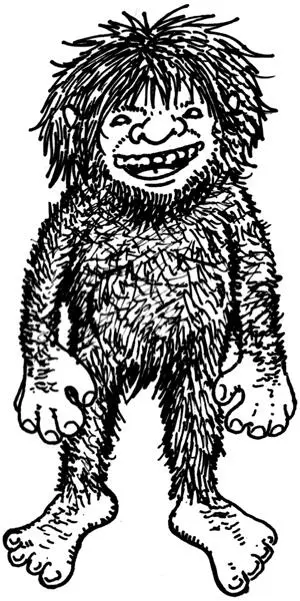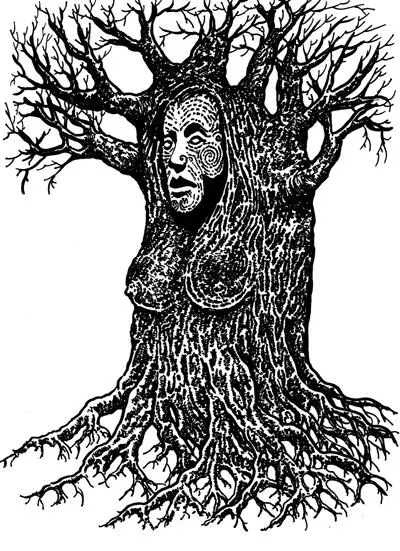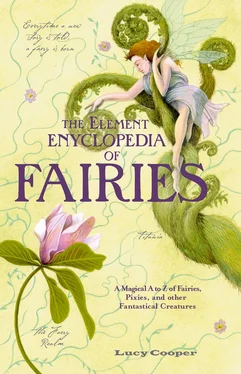However, a different creature altogether, the Bodach Glas , or Dark Gray Man, is described in Waverley by Sir Walter Scottas being a gray specter warning of impending death or catastrophe.
A helpful barn brownie, the Little Old Man of the Barn “will thresh with no light in the mouth of the night” while the old farmer sleeps, according to a verse in D. A. Mackenzie’s Scottish Folk-lore and Folk Life (1935) .
See Bauchan .
Tales of the Bag-man, or Man with the Sack, are told in many cultures to frighten children into good behavior. They generally portray him as a nebulous, threatening spirit carrying a bag or sack on his back in which he puts children who misbehave.

There are many local tales of this mischievous, sometimes malevolent, brownie, either in the guise of a household spirit who steals the food from the table and torments the family or as a tricksy field-dweller.
In an old Lincolnshire story the boggart is described as “a squat hairy man, strong as a six-year-old horse, and with arms almost as long as tackle poles” who declares he is the rightful owner of the land a farmer has purchased; however, the farmer is cunning and agrees that they should share the disputed field, asking the boggart to choose whether he will take what lies above or below the earth. The boggart chooses to take what grows above ground, and the farmer promptly sets potatoes. Whichever choice the boggart makes, the farmer thwarts him, until the boggart leaves in disgust, telling the farmer he wants nothing more to do with his land. “And off he goes and nivver comes back no more …”
A name encompassing a variety of troublesome spirits such as bug-a-boos, bugbears, boggarts, and bogles, whose aim is to sow discord and mischief among humans, although as in the tale of the boggart ( see here ), they can sometimes be outwitted by a quick mind and clever tongue.
See Awd Goggie , Churnmilk Peg , Gooseberry Wife , Jack in Irons , Jenny Greenteeth , Melsh Dick , Mumpoker , Nursery Bogies , Padfoot , Shellycoat , Rawhead and Bloody Bones .
Supernatural female water spirits in Polish mythology, “little goddesses” who sometimes steal human babies, replacing them with changelings.
In Notes on the Folklore of the Northern Counties of England and the Borders (1866) by W. Henderson, bogles are described in one tale as possessing a rather better nature than most goblins, only bedeviling wrong-doers in a retributive manner; however, in another account a bogle haunts a household and can only be got rid of with the aid of a Bible, whereupon he hastily departs in the form of a gray cat. After many years he reappears as a death omen just before the man of the house is killed in the mines.
Another haunting tale is of Berry Well, in a village in Yorkshire, where a bogle takes on the shape of a white goose.
A Native American wild forest spirit of the Pacific northwest coast. Masks portray him as beetle-browed and with a beaklike nose, and he lures the spirits of the drowned to live with him in his forest dwelling.
Spirits in the folklore of the Santal people of India. Bongas permeate every area of life in the form of ancestor spirits, household spirits, and nature spirits dwelling in hills, trees, and rocks. They are propitiated by elaborate ceremonies that often culminate in dances and the drinking of rice beer. Like their European fairy counterparts, they are capricious, choosing either to bring good or ill fortune to the humans whose affairs they take an interest in. They can assume human form, and there are many tales of bonga girls or maidens wedded to human grooms, who bring either happiness or torment to their mortal husbands.
The kisar bonga is a household spirit; similar to a Scottish brownie, he brings prosperity to his master if treated with due respect, but is quick to take offense and withdraw his help.
In the northern isles of Orkney and Shetland, the Booman hobgoblinis variously described as a “good fairy,” by Edmonston in the nineteenth century, or in other folk tales as a frightening presence haunting lonely roads. Today he is remembered mainly in a traditional game which involves enacting a funeral while singing “Booman is dead and gone” and in other folk songs.

Tree spirits, or nats , in Burmese folk beliefs. They reside among the tree’s roots. Other types of tree-dwelling nat , such as the akakasoh and the shekkasoh , make their homes in other parts of the tree.
Bottrell, William (1816–1881)
Writer and folklorist William Bottrell was born near St. Levan, a few miles from Land’s End in Cornwall, England. He was educated at Penzance Grammar School until 1831 and later at Bodmin School. His grandmother told him traditional Cornish stories from a young age and was a great influence on his future writings. These stories had been handed down for generations.
Bottrell traveled extensively and bought some land in the Basque region of Spain, where he gathered more traditional folk tales. The land was later confiscated and he returned, ruined, to Cornwall. He settled on a smallholding near Lelant where he gathered more stories from the tin miners of the area. He recounted these tales to Robert Hunt, who used them in his own publications. Bottrell was encouraged by the editor of the Cornish Telegraph to write and publish the tales himself and the first of these writings appeared in that newspaper in 1867. He also wrote for the periodicals One and All and the Reliquary .
Bottrell’s tales tell of giants, mermaids, witches, and Cornish fairies such as buccas , knockers, and spriggans(apparently he had a black cat named Spriggans). The tales were compiled into three volumes, the first of which was Traditions and Hearthside Stories of West Cornwall vol. I (1870); the second volume was published in 1873, and the third, Stories and Folklore of West Cornwall , in 1880.
Literally, “God’s Plaint,” a banshee-like spirit in Wend folklore of eastern Germany. Like the Irish banshee, she is an omen of impending death and weeps in lament beneath the window of those about to die. In some accounts she is described as a small woman with long hair; in others she is associated with the elder tree and is described as a red-eyed woman clad in white with long, braided hair.
Читать дальше














